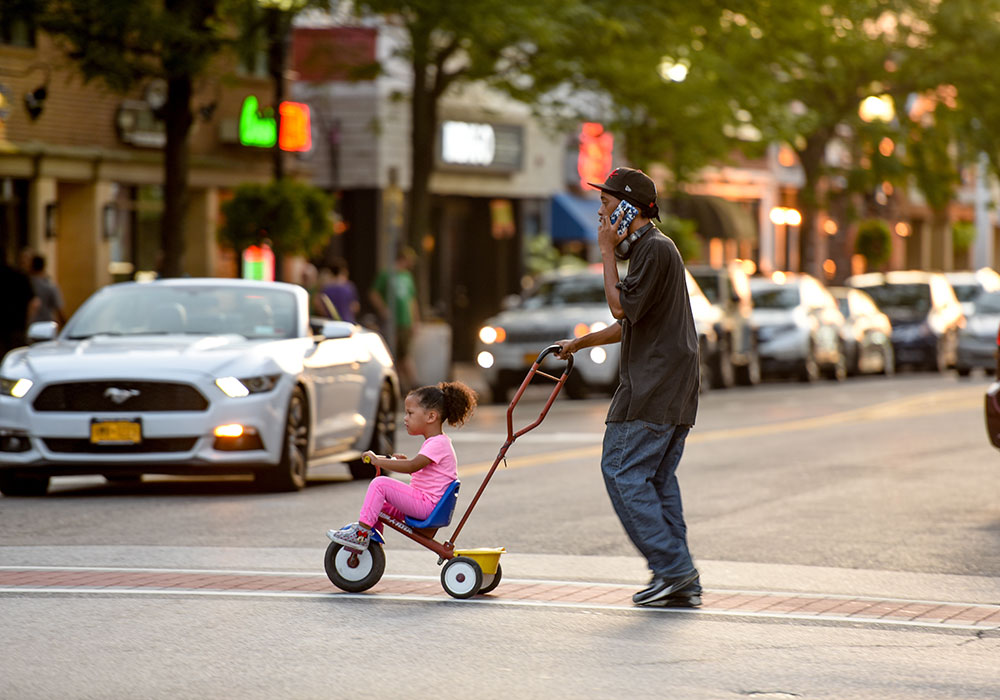Downtown Patchogue Village: Patchogue, New York
In 1996, the New York Times described Downtown Patchogue Village on Long Island as "dilapidated," with building windows "boarded up and extensive fire damage visible from the street." But the village's circumstances were not always so dire. Its decline was gradual over a period of more than 40 years, precipitated by events and national trends that left the neighborhood in a state of disrepair.
The village's troubles began in the 1950s when travelers began going elsewhere for their vacations. Changes in technology meant the end of wooden boat building and other local industries. The historic lace mill at the edge of town, a long-time employer, closed and would remain shuttered for decades. A large regional indoor shopping mall opened nearby, pulling local shoppers away from the downtown.
By the 1980s, Patchogue was considered a ghost town. Only a few local anchor institutions like Patchogue Theater and Sweezy's, a local family-owned department store, remained. Eventually, those failed too, leaving little hope for the future.

An anchor of the neighborhood and a regional attraction, renovated historic Patchogue Theater is widely considered the catalyst that jump-started the renewal of the village. Photo by Benny Migs.
Still, a determined group of local and regional leaders, residents, and business owners believed that a better future was possible. The first signs of a rebirth began in 1998 when the historic Patchogue Theatre for the Performing Arts reopened, following major renovations to the space that had been shuttered for nearly a decade. Shortly thereafter, the Suffolk County Planning Department conducted a study that resulted in a plan with a vision for successful revitalization efforts. With the help of public grants used to upgrade building exteriors and infrastructure and the rezoning of derelict industrial spaces to living spaces, new investments in housing, transportation, and local businesses grew.
A number of transformative projects were completed in the first decade of the new century, including New Village, a shuttered department store turned multifamily housing complex of 291 new market-rate and affordable units. Transportation projects established Downtown Patchogue Village as a regional hub for the county bus system, connected residents to regional railways, and made the village safe and accessible to people walking and biking.
Some community members expressed concerns about new rental housing unit development, arguing that more housing options would translate to less parking and greater density that would ruin the historic character of the neighborhood. Proponents said new housing options would bring further investment and life to Patchogue. Third-term Mayor Paul Pontieri and many other local leaders championed the project. To ease residents' fears, planners worked closely with neighbors to ensure their properties were protected, historic structures were preserved, adequate parking was provided, and the design of new buildings respected the character of the area.
Community programming and support for the arts have also greatly contributed to Patchogue's renaissance. Alive at Five and Art on Terry, outdoor street festivals featuring performances by local, regional, and international musicians and artists, have proved to be major economic catalysts for the downtown, attracting more than 25,000 visitors each summer. Local artists continue to support the revival of Patchogue through their involvement in the Patchogue Arts Council, leading on local beautification projects designed to improve downtown visitors' downtown experience.

Father and daughter crossing the street in Downtown Patchogue Village. Photo by Benny Migs.
"The strength of any community is driven by its diversity, its commitment to the future, and residents' willingness to volunteer to make their Village a better place. By creating a vibrant downtown, the Village of Patchogue has become a place for professionals and young families the to live and grow."
—Mayor Paul V. Pontieri Jr.
According to a recent economic study, Patchogue's revitalization generated over $693.3 million in economic output and supported nearly 6,000 jobs. A mix of new housing options, including apartments, single-family homes, condos, and assisted living for senior residents, are drawing young professionals, families, and retirees to the downtown core. Downtown Patchogue Village is regarded as one of the region's best community improvement success stories and serves as a model for transit-oriented development and smart growth throughout Long Island.


